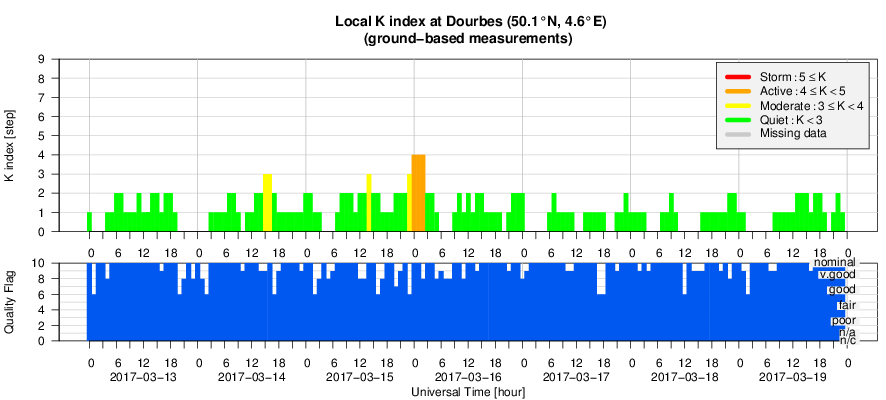- Table of Content
- 1.Sleeping Beaut...
- 2.The hunt for f...
- 3.PROBA2 Observa...
- 4.Review of sola...
- 5.The Internatio...
- 6.Geomagnetic Ob...
- 7.Review of iono...
- 8.Future Events
2. The hunt for fake flares
3. PROBA2 Observations (13 Mar 2017 - 19 Mar 2017)
4. Review of solar and geomagnetic activity
5. The International Sunspot Number
6. Geomagnetic Observations at Dourbes (13 Mar 2017 - 19 Mar 2017)
7. Review of ionospheric activity (13 Mar 2017 - 19 Mar 2017)
8. Future Events
Sleeping Beauty
On 21 March, a tiny spot near the Sun's east limb marked the end of a spotless stretch that started on 6 March. That means that no sunspot had been observed for 15 consecutive days (preliminary numbers). This is the longest stretch of spotless days for the current solar cycle transit SC24-25 (see the SILSO-data at http://sidc.oma.be/silso/eisnplot and the plot elsewhere in this Newsletter).
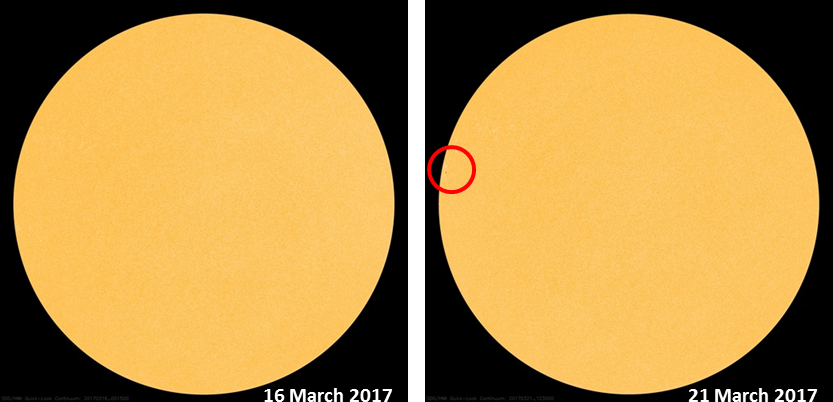
To put this period somewhat in perspective, we have to go back all the way to 2008-2009 (the previous solar cycle minimum) to find spotless periods of comparable duration. The table underneath provides a list with the *most recent* stretches of a specific number of spotless days (for 15 days and more; column "Period ISN=0"). There have been of course many more such periods in the past decades (except for 29 days). The previous solar cycle minimum was long and deep, as can be judged from the numerous SC24 entries in the table. Nonetheless, the 6-20 March 2017 spotless stretch wiped off the 21 May-4 June 2008 period from the table.
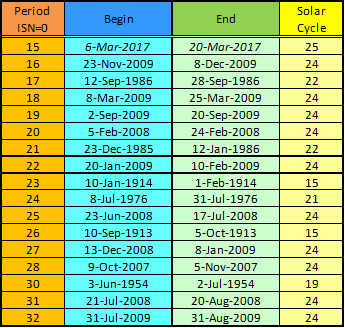
With the solar cycle minimum just starting, many more and much longer spotless periods can be expected. A table with all the spotless periods of 30 or more consecutive days (since 1849) can be found at the dedicated SILSO's Spotless Days page at http://sidc.oma.be/silso/spotless The next update of this page is scheduled for early April.
The hunt for fake flares
After our ghostbusters action, our people revealed themselves also as excellent hunters … of false flares. Flares are bursts of solar light and are categorised by how strong they shine in X-rays. American satellites GOES monitor 24/7 the solar X-rays. Based on their measurements, a list of solar flares is put together.
We have an instrument LYRA onboard the ESA micro-satellite PROBA2 that makes similar measurements, only it detects flares with a slightly other energy. Ingolf Dammasch, our LYRA expert, noted that in the GOES list flares where mentioned which did not appear in LYRA observations. Even if LYRA measures slightly different energies than GOES, the observations should give more or less the same result.
Indeed, the automated detection system picked up false flares from the noisy GOES data. Large flares were still identified correctly, the small ones fooled the processing code but not us. So we alarmed the GOES operators.
Ingolf Dammasch is now officially recordholder of catching non-existing flares. A good catch!
Below, find an overview image of the 45 most eXtreme flares that PROBA2 could catch since November 2009 when it took off to space.

http://www.stce.be/news/370/welcome.html
PROBA2 Observations (13 Mar 2017 - 19 Mar 2017)
Solar Activity
Solar flare activity fluctuated between low to very low during the week.
In order to view the activity of this week in more detail, we suggest to go to the following website from which all the daily (normal and difference) movies can be accessed: http://proba2.oma.be/ssa
This page also lists the recorded flaring events.
A weekly overview movie can be found here (SWAP week 364).
http://proba2.oma.be/swap/data/mpg/movies/weekly_movies/weekly_movie_2017_03_13.mp4
Details about some of this week’s events, can be found further below.
If any of the linked movies are unavailable they can be found in the P2SC movie repository here.
http://proba2.oma.be/swap/data/mpg/movies/
Thursday March 14
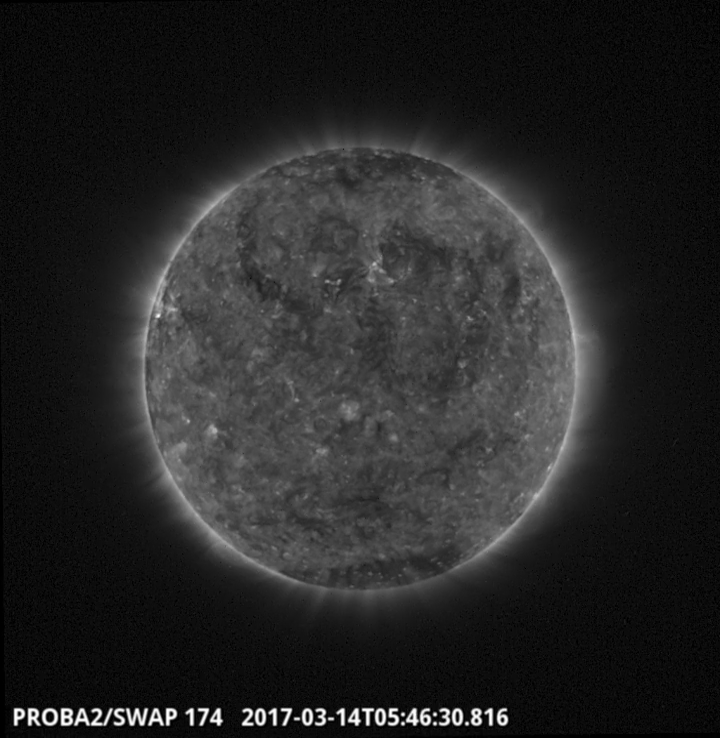
The largest flare of the week was a B2.5, peaking at 05:46 UT on the East Limb.
Find a movie of the event here (SWAP movie)
http://proba2.oma.be/swap/data/mpg/movies/20170314_swap_movie.mp4
Sunday March 19
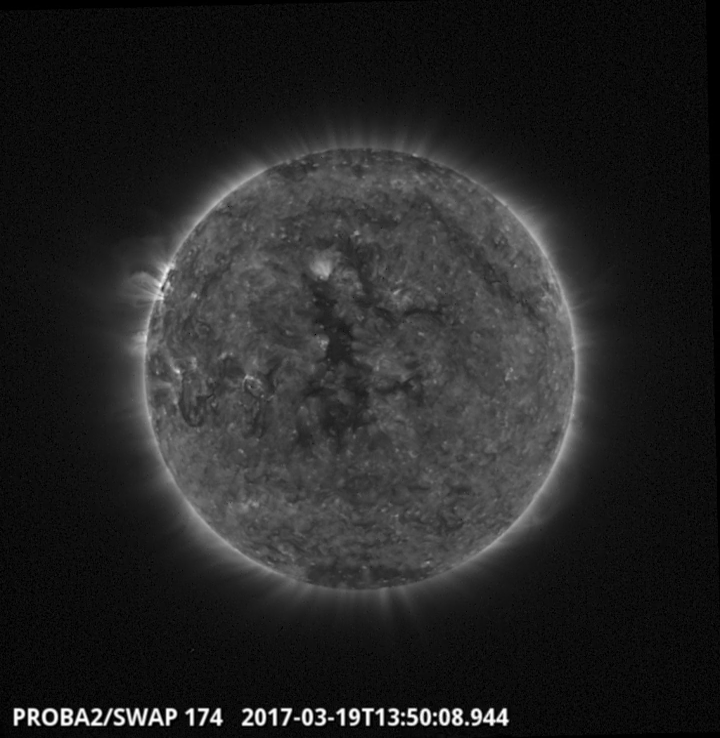
A large coronal hole passed over the solar disk, on 2013-Mar-19 it was located near the disk centre
Find a movie of the event here (SWAP movie)
http://proba2.oma.be/swap/data/mpg/movies/20170319_swap_movie.mp4
Review of solar and geomagnetic activity
SOLAR ACTIVITY
Solar activity was very low. No significant flares have been recorded. No Earth directed Coronal Mass Ejections (CMEs) have been detected. A partial halo CME was visible in SoHO/LASCO C2 images from 20:00 UT onwards on March 13. The ejection was mostly directed towards the North West and had an angular extent of approximately 180 degrees. The event was believed to be back-sided and therefore not influence the Earth.
GEOMAGNETIC ACTIVITY
The solar wind speed has fluctuated between 340 and 430 km/s over the past week. The total magnetic field strength has fluctuated between 1 and 10 nT peaking on 15-Mar-2017. The Bz component fluctuated between -5 and +7 nT. Geomagnetic conditions ranged between Kp index 0-4 (NOAA) and local K index 0-3 (Dourbes) over the past week.
Check the space weather briefing from the SIDC, http://www.sidc.be
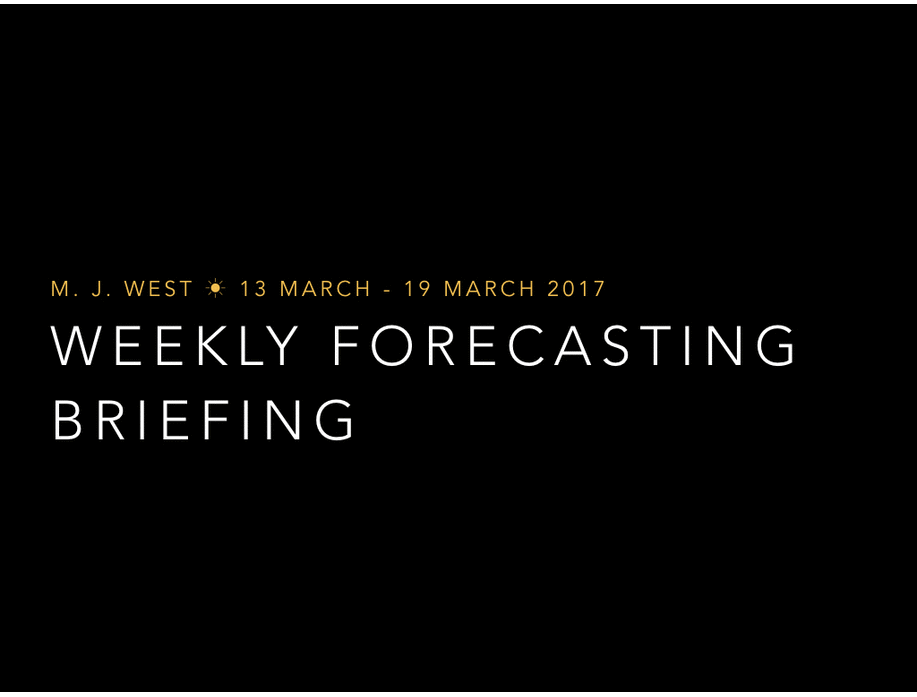
The International Sunspot Number
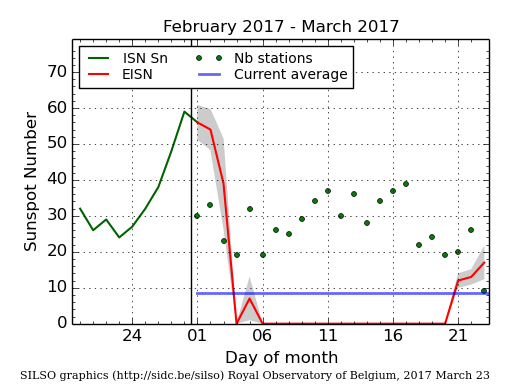
The daily Estimated International Sunspot Number (EISN, red curve with shaded error) derived by a simplified method from real-time data from the worldwide SILSO network. It extends the official Sunspot Number from the full processing of the preceding month (green line). The plot shows the last 30 days (about one solar rotation). The horizontal blue line shows the current monthly average, while the green dots give the number of stations included in the calculation of the EISN for each day.
Review of ionospheric activity (13 Mar 2017 - 19 Mar 2017)
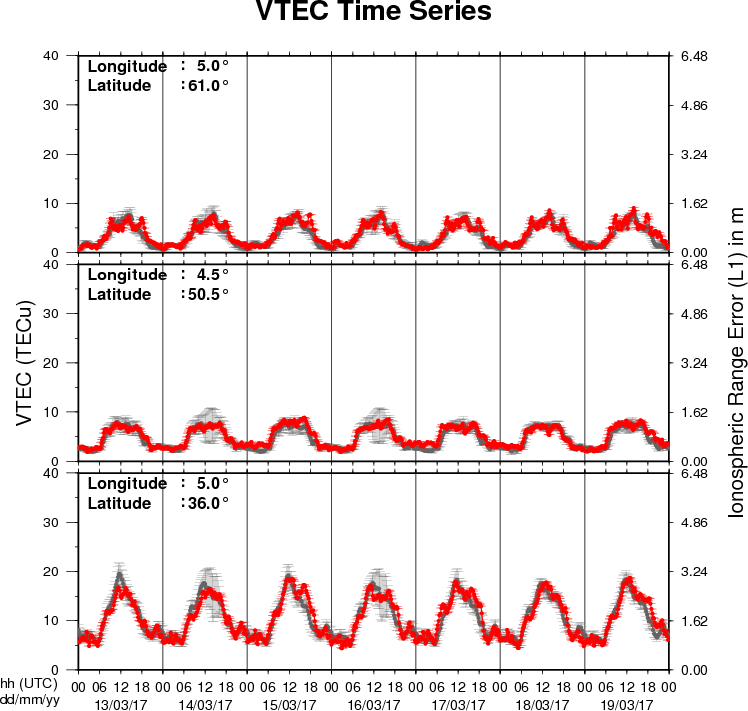
The figure shows the time evolution of the Vertical Total Electron Content (VTEC) (in red) during the last week at three locations:
a) in the northern part of Europe(N61°, 5°E)
b) above Brussels(N50.5°, 4.5°E)
c) in the southern part of Europe(N36°, 5°E)
This figure also shows (in grey) the normal ionospheric behaviour expected based on the median VTEC from the 15 previous days.
The VTEC is expressed in TECu (with TECu=10^16 electrons per square meter) and is directly related to the signal propagation delay due to the ionosphere (in figure: delay on GPS L1 frequency).
The Sun's radiation ionizes the Earth's upper atmosphere, the ionosphere, located from about 60km to 1000km above the Earth's surface.The ionization process in the ionosphere produces ions and free electrons. These electrons perturb the propagation of the GNSS (Global Navigation Satellite System) signals by inducing a so-called ionospheric delay.
See http://stce.be/newsletter/GNSS_final.pdf for some more explanations ; for detailed information, see http://gnss.be/ionosphere_tutorial.php
Future Events
For more details, see http://www.spaceweather.eu/en/event/future
International CCMC-LWS Workshop in Cape Canaveral, Florida (USA)
Start : 2017-04-03 - End : 2017-04-07
The goal of this working meeting is to address the need to
quantify and to track progress over time in the field of space
weather and to establish internationally recognized metrics that
are meaningful to end-users and developers. Defining a set of
appropriate metrics is important to track advancements in space
weather understanding and predictive capabilities.
This meeting is a part of the unfolding activities of the
International Forum for Space Weather Capabilities Assessment that
brings together space environment experts, model and application
developers, data providers, forecasters and end-users. The goals of
this community-wide forum include addressing challenges in
model-data comparisons and evaluating the current state of space
environment predictive capabilities. Workshop attendance is
encouraged but is not a requirement for joining forum teams.
Website:
http://ccmc.gsfc.nasa.gov/CCMC-LWS_Meeting/
Solar Orbiter Workshop 7: Exploring the solar environs in Granada, Spain
Start : 2017-04-03 - End : 2017-04-06
This event will be hosted by the Instituto de Astrofisica de
Andalucia - CSIC. Please mind that on April 7th the 20th SWT
meeting will take place at the same venue.
Website: Unkown
URSI General Assembly in Montreal, Canada
Start : 2017-08-19 - End : 2017-08-26
For the thirty-second time since the inception of URSI, Radio
Scientists from across the world will get together for the URSI
General Assembly and Scientific Symposium. This triennial gathering
will take place from 19th to 26th of August 2017, in Montreal,
Canada. This conference is a unique opportunity to learn about
recent advances in all fields of Radio Science, as covered by all
ten URSI Commissions.
Among the different sessions, please note:
* 'Radio Science for Space Weather'
Conveners: M. Messerotti, V. Pierrard
* 'Remote Sensing and Modeling of the Earth's Plasmasphere
and Plasmapause'
Conveners: A. M. Jorgensen, V. Pierrard, B. Heilig
The abstract deadline is 30 January 2017
Website: http://www.ursi2017.org
2017 Joint IAPSO-IAMAS-IAGA Assembly in Cape Town, South Africa
Start : 2017-08-27 - End : 2017-09-01
The Joint IAPSO-IAMAS-IAGA Assembly, endorsed by the University
of Cape Town and the South African Department of Science and
Technology, will take place from 27 August to 1 September 2017 at
the Cape Town International Convention Centre (CTICC). Several IAGA
and IAMAS sessions are of Space Weather interests as well as the
joint session 'Space Weather throughout the Solar System: Bringing
Data and Models together'.
Website:
http://iapso-iamas-iaga2017.com/index.php
Workshops on Radiation Monitoring for the International Space Station in Torino, Italy
Start : 2017-09-05 - End : 2017-09-07
The Workshop on Radiation Monitoring for the International Space
Station is an annual meeting to discuss the scientific definition
of an adequate radiation monitoring package and its use by the
scientific community on the ISS. Types of instruments and research
topics need to be defined in order to optimise the radiation safety
of the ISS crew.
Website: http://wrmiss.org/
European Space Weather Week 14
Start : 2017-11-27 - End : 2017-12-01
The ESWW is the main annual event in the European Space Weather
calendar. It is the European forum for Space Weather as proven by
the high attendance to the past editions. The agenda will be
composed of plenary/parallel sessions, working meetings and
dedicated events for service end-users. The ESWW will again adopt
the central aim of bringing together the diverse groups in Europe
working on different aspects of Space Weather.
Website:
http://www.stce.be/esww14/
